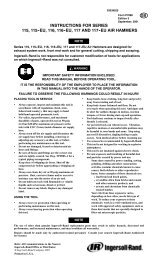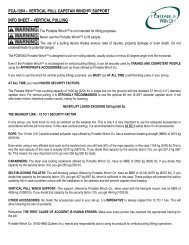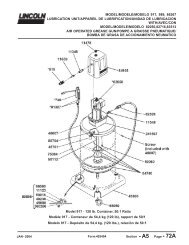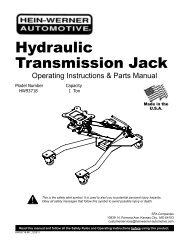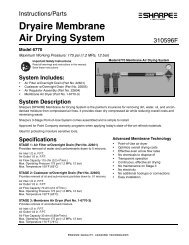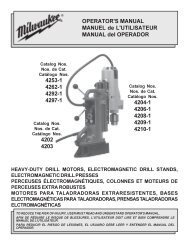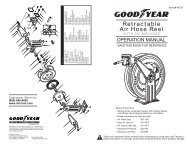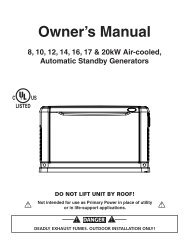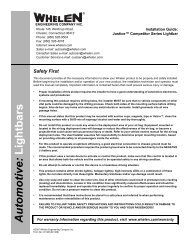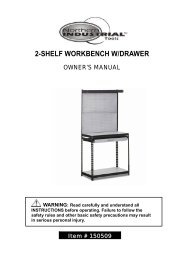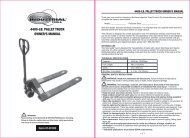Owner's Manual - Northern Tool + Equipment
Owner's Manual - Northern Tool + Equipment
Owner's Manual - Northern Tool + Equipment
You also want an ePaper? Increase the reach of your titles
YUMPU automatically turns print PDFs into web optimized ePapers that Google loves.
©2007 <strong>Northern</strong> <strong>Tool</strong> + <strong>Equipment</strong><br />
TM<br />
M1577541G<br />
ITEM NUMBERS: 1577541,<br />
1577542<br />
Owner’s <strong>Manual</strong><br />
Pressure Washer: Machine that cleans dirty<br />
surfaces with high pressure water.<br />
WARNING<br />
Read this manual.<br />
Serious injury or death can result if safety instructions are not followed.<br />
Engine is shipped without oil.<br />
- Before starting engine, fill engine oil.<br />
- See engine manual for engine oil requirements.<br />
Pump is shipped with oil.<br />
- Remove shipping plug and install vented fill cap.<br />
- See pump oil cap section of this manual.<br />
Closely inspect all components.<br />
-If you have damaged components then: Contact the freight company that<br />
delivered the unit and file a claim.<br />
-If you have missing components then: Contact Customer Service at<br />
1-800-270-0810.<br />
Any Questions, Comments, Problems or Parts Orders<br />
Call NorthStar Product Support 1-800-270-0810
Hazard Signal Word Definitions<br />
2
Table of Contents<br />
Important Safety Rules ........................................…..4,5<br />
Warning Label Locations .....................................……6<br />
Assembly Instructions……………………………………7-11<br />
Machine Component Identification………………………12<br />
Pump Oil Cap and Pump Component Identification…...13<br />
Operation Instructions ........................................… 13-17<br />
Water Supply……………….……………………….…13<br />
Start-Up/Shut-Down Instructions…………………….14<br />
Spray Gun Safety Lock……………………………….15<br />
Attaching the Lance……………………………….…..15<br />
Installing Nozzles……………………………………...16<br />
Quick Connect hoses…………………………………16<br />
Applying Chemicals..………………………………….17<br />
Maintenance....................................……………….. 18,19<br />
Maintenance Mode……………………………………18<br />
Maintenance Schedule……………………………….18<br />
Pump Oil Change….………………………………….19<br />
Storage....................................……………………….19<br />
Long Term Storage……………………………………19<br />
Winter Storage…………………………………………19<br />
Troubleshooting ...................................……............... ...20<br />
Specifications .....................….................................…...20<br />
Parts Explosions ......................................................…..21<br />
3
Important Safety Rules<br />
WARNING<br />
1.) Read owner's manual completely.<br />
Serious injury or death can result if safety instructions are not followed. You must be<br />
16 or older to operate this machine. Keep untrained people away.<br />
2.) Skin puncture hazard.<br />
High pressure fluid can inject under skin resulting in serious injury including<br />
amputation. Do not direct spray at people or animals.<br />
-If skin injection happens, seek IMMEDIATE surgical treatment.<br />
-Do not check for leaks with hand. Instead, use a piece of cardboard to check for<br />
leaks.<br />
-Do not use unit if exterior hose damage is evident. Make sure all fittings are tight<br />
before starting. Relieve system pressure before servicing.<br />
-Know how to stop engine and bleed pressures quickly. Be thoroughly familiar with<br />
the controls.<br />
-Make sure accessories meet the unit's temperature and pressure limits.<br />
-Stop engine, bleed pressure, and engage spray gun safety lock before leaving unit<br />
unattended.<br />
3.) Risk of fire and explosion.<br />
Hot exhaust fumes from engine can cause fire. Gasoline is highly flammable and<br />
explosive. You can be burned or seriously injured when handling fuel.<br />
-Position muffler at least 7 feet from combustible objects.<br />
-Before adding fuel, stop the engine and keep heat, sparks, and flame away. Do not<br />
add fuel when engine is running or still hot. No smoking near engine.<br />
-Do not pump fuel directly into engine at gas station. Static charge can build and<br />
ignite fuel. Use a UL approved fuel container to transfer gas to the engine. Wipe up<br />
fuel spills immediately.<br />
-Only store and handle fuel outdoors. Gasoline vapors can ignite if they collect<br />
inside an enclosure. Explosion can result.<br />
-Do not change or add to exhaust system. Fire can result.<br />
-Do not change or add fuel tanks or fuel lines. Fire can result.<br />
-Before each use, check fuel tank and fuel lines for leaks. Any fuel leak is a fire<br />
hazard. Fix any fuel leaks before starting engine.<br />
-During transportation take precautions to make sure pressure washer will not tip<br />
over and cause a fuel leak fire hazard.<br />
4.) Poisonous gas.<br />
This machine gives off carbon monoxide, a poisonous gas that can kill you. You<br />
CANNOT smell it, see it, or taste it.<br />
-ONLY run machine outdoors and away from air intakes.<br />
-NEVER run machine inside homes, garages, sheds, or other semi-enclosed spaces.<br />
These spaces can trap poisonous gases, EVEN IF you run a fan or open doors and<br />
windows.<br />
If you start to feel sick, dizzy, or weak while using this machine, shut it off and get to<br />
fresh air RIGHT AWAY. See a doctor. You may have carbon monoxide poisoning.<br />
Save These Instructions<br />
4
Important Safety Rules<br />
WARNING<br />
5.) Risk of exposure to dangerous chemicals.<br />
Serious injury or death can result if chemical manufacturer instructions are not<br />
followed.<br />
-Wear protective gloves when handling and cleaning with chemicals.<br />
-Understand all safety hazards and first aid for all chemicals being used.<br />
-When cleaning filters, check if chemicals have been used and take any<br />
precautions that are recommended by the chemical manufacturer.<br />
-Different chemicals may interact dangerously with each other, always follow<br />
chemical manufacturer directions before switching chemicals.<br />
-Calculate the correct amount of chemical to mix, dispose of excess chemical<br />
per the manufacturer instructions.<br />
-Never spray flammable liquids.<br />
6.) Risk of electrocution.<br />
Electricity can kill you. Keep water away from electrical outlets and electrical<br />
devices.<br />
7.) Flying objects.<br />
Small particles may fly out while spraying. Wear safety glasses. Serious eye<br />
injury can occur.<br />
Make sure nozzle is secure before squeezing trigger. If nozzle is not secure it<br />
will become a projectile.<br />
8.) Fall hazard.<br />
Pressure washer creates puddles and slippery surfaces. Keep good footing<br />
and balance. Serious injury can occur.<br />
-Wear footwear cabable of maintaining a good grip on wet surfaces.<br />
-Gun kicks back. Hold with both hands.<br />
-Do not overreach or stand on unstable supports.<br />
-Do not stand on ladders or scaffolding.<br />
-Do not place pressure washer on soft or unstable ground.<br />
CAUTION<br />
1.) Hot muffler.<br />
You can be burned by muffler. Do not touch.<br />
Save These Instructions<br />
5
Engine and pump not<br />
shown for clarity.<br />
Warning Label Locations<br />
WARNING<br />
1.) Skin puncture hazard. Do<br />
not direct spray at people or<br />
animals. Seek IMMEDIATE<br />
surgical treatment.<br />
2.) Risk of fire and explosion.<br />
Do not add fuel when engine is<br />
running or still hot.<br />
3.) Breathing hazard.<br />
Poisonous fumes from engine<br />
can kill you. Do not operate<br />
indoors even if ventilated.<br />
4.) Risk of electrocution.<br />
Keep water away from electric<br />
outlets and electric devices.<br />
5.) Read owner's manual.<br />
Serious injury or death can<br />
result if safety instructions are<br />
not followed.<br />
©2003 K-Bar Industries 800-270-0810 Part No. 38570<br />
Call 1-800-270-0810 to order new labels.<br />
Instruction Label: Part No. 32538<br />
Warning Label: Part No. 38570 (includes hot<br />
muffler caution located on engine)<br />
START-UP INSTRUCTIONS<br />
1. Attach garden hose.<br />
2. Attach pressure hose.<br />
3. Attach gun and lance.<br />
4. Turn water supply ON.<br />
5. Squeeze trigger to<br />
purge air from pump.<br />
6. Insert nozzle.<br />
7. Start engine.<br />
SHUT-DOWN INSTRUCTIONS<br />
1. Turn engine OFF.<br />
2. Turn water supply OFF.<br />
3. Squeeze trigger to<br />
relieve system pressure.<br />
4. Remove garden hose.<br />
5. Remove pressure hose.<br />
6. Turn fuel valve OFF<br />
(if equipped).<br />
6
Assembly Instructions<br />
I.) Unpack<br />
Your pressure washer is shipped in two boxes. Separate and identify the components found in<br />
both boxes.<br />
01876<br />
Engine/ Pump assembly Base Handle<br />
Leg Pressure Hose Lance<br />
Spray Gun Wheels Hardware Bag<br />
Any Questions, Comments, Problems or Parts Orders<br />
Call NorthStar Product Support 1-800-270-0810<br />
7
II.) Hardware Bag<br />
¾” Nut<br />
Qty – 4<br />
Part # 82040<br />
¾” Lock washer<br />
Qty – 2<br />
Part # 82041<br />
Rubber foot<br />
Qty – 2<br />
Part # 2215<br />
¾” x 4” Bolt<br />
Qty – 2<br />
Part # 82230<br />
Assembly Instructions<br />
Vented fill cap<br />
Qty - 1<br />
Nozzle<br />
Qty – 2<br />
Part # 38530<br />
Grommet<br />
Qty – 5<br />
Part # 777111<br />
Gun hook<br />
Qty – 2<br />
Part # 38509<br />
5/16” Nut<br />
Qty – 16<br />
Part # 82019<br />
5/16” x ¾” Bolt<br />
Qty – 2<br />
Part # 82015<br />
5/16” x 1 1/2” Bolt<br />
Qty – 4<br />
Part # 82017<br />
5/16” x 2” Bolt<br />
Qty – 4<br />
Part # 82018<br />
Hose hook<br />
Qty – 1<br />
Part # 38510<br />
8
III.) Cart Assembly<br />
Step 1.) Fasten rubber feet onto<br />
leg with wrench.<br />
Step 2.) Fasten leg with feet and<br />
handle to<br />
base with wrench.<br />
base<br />
5/16” nut<br />
handle<br />
5/16” x 2” bolt<br />
Assembly Instructions<br />
rubber foot<br />
leg<br />
5/16” nut<br />
5/16” x ¾” bolt<br />
leg with feet<br />
9
¾” x 4” bolt<br />
wheel<br />
¾” lock washer<br />
Assembly Instructions<br />
Step 3.) Slide ¾” x 4” bolt through wheel and fasten with 3/4” nut hand tight.<br />
¾” nut<br />
Step 4.) Fasten wheel assemblies to base with wrench. Check that wheels turn freely.<br />
wheel assembly<br />
¾” nut<br />
base<br />
10
5/16” nut<br />
Hook Detail<br />
Step 5.) Thread 5/16” nuts onto<br />
hooks, then fasten hooks to<br />
handle with wrench. Point top<br />
gun hook away from tires.<br />
Point bottom gun hook<br />
toward tires.<br />
Point hose hook up, press<br />
grommets into base.<br />
Step 6.) Fasten engine to base with wrench.<br />
engine<br />
5/16” x 1 1/2” bolt<br />
Assembly instructions<br />
gun hook<br />
nozzle<br />
grommet<br />
5/16” nut<br />
hose hook<br />
5/16” nut<br />
base<br />
11
Machine Component Identification<br />
01882<br />
1.Handle. Designed for easy<br />
cart movement.<br />
2.Hose Hook. Store pressure<br />
hose on hook.<br />
3.Pressure Hose. Attach quick<br />
couplers to gun and water outlet.<br />
4.Chemical Hose. Submerge in<br />
cleaning solution.<br />
5.Water Pump. Inspect for<br />
loose/broken parts prior to each<br />
use.<br />
6.Engine. Honda engine<br />
provides years of reliable use.<br />
7.Gun Hook. Store gun here.<br />
8.Nozzles. Change nozzles for<br />
different spray patterns<br />
9.Spray Gun. Always use two<br />
hands for safe operation.<br />
10.Trigger. Actuate to allow<br />
pressurized water to flow out of<br />
spray gun.<br />
12
Shipping plug<br />
(Install Vented<br />
Fill Cap*)<br />
Pump Oil Cap and Pump Component Identification<br />
Water Inlet<br />
Water Outlet<br />
Pressure<br />
Adjustment<br />
*Note: Discard Shipping Plug and O-ring<br />
Shipping plug (Install<br />
Vented Fill Cap*)<br />
Water Inlet<br />
Operation Instructions<br />
Water Outlet<br />
Water Supply<br />
1.) Make sure the water supply is clean. Debris can cause excess pump wear and reduce<br />
performance.<br />
2.) An insufficient water supply will damage your pump. Make sure the water supply is steady and is<br />
20% over the rated flow of your pump. Use a stopwatch to time how long it takes to fill a 5 gallon<br />
bucket with your garden hose. The bucket must be filled faster than 100 seconds.<br />
3.) The water supply garden hose must have an inside diameter of at least 5/8”. If the hose is more<br />
than 100 ft. long, the diameter must be at least 3/4”.<br />
4.) Never use a reservoir tank as a water source. Drawing water out of a tank may cause pump<br />
cavitation and damage to your pump. This pressure washer is designed for a pressurized water<br />
source such as a city water faucet. However, the water source pressure must not exceed 115 psi<br />
(8 bar).<br />
5.) Always use a flexible rubber hose for your water supply. Do not use rigid piping.<br />
13
Start-Up Instructions<br />
1. Attach garden hose to water inlet.<br />
2. Attach pressure hose to water outlet and gun.<br />
3. Attach spray gun to lance.<br />
4. Turn water supply ON.<br />
5. Squeeze trigger to purge air from pump.<br />
6. Insert nozzle.<br />
7. Start engine.<br />
Shut-Down Instructions<br />
1. Turn engine OFF.<br />
2. Turn water supply OFF.<br />
3. Squeeze trigger to relieve system pressure.<br />
4. Remove garden hose.<br />
5. Remove pressure hose.<br />
Operation Instructions<br />
WARNING<br />
Skin puncture hazard.<br />
High pressure fluid can inject under skin resulting in serious injury including<br />
amputation. Do not direct spray at people or animals.<br />
-If skin injection happens, seek IMMEDIATE surgical treatment.<br />
-Do not check for leaks with hand. Instead, use a piece of cardboard to check for<br />
leaks.<br />
-Do not use unit if exterior hose damage is evident. Make sure all fittings are tight<br />
before starting. Relieve system pressure before servicing.<br />
-Know how to stop engine and bleed pressures quickly. Be thoroughly familiar with<br />
the controls.<br />
-Make sure accessories meet the unit's temperature and pressure limits.<br />
-Stop engine and bleed pressures before leaving unit unattended.<br />
14
Spray Gun Safety Lock<br />
Operation Instructions<br />
When not spraying, use the spray gun safety lock to prevent accidental high pressure discharge.<br />
Attaching the Lance<br />
Tighten spin-on coupler hand tight.<br />
Note: The o-rings make the seal so there is no need to tighten with a wrench.<br />
lance<br />
spray gun<br />
spin-on coupler<br />
spray gun<br />
safety<br />
lock<br />
15
WARNING<br />
Flying objects.<br />
Make sure nozzle is secure before squeezing trigger. If nozzle is not secure it will become a<br />
projectile. Serious injury can occur.<br />
pump<br />
Operation Instructions<br />
Installing Nozzles<br />
To install a nozzle pull back the collar and push the nozzle into the coupler. Once the connection is<br />
made, pull on the nozzle to make sure it is secure.<br />
nozzle<br />
collar<br />
collar completely<br />
pushed out.<br />
CORRECT INCORRECT<br />
Attach Quick Connect Couplers<br />
-To install the hose onto the pump, pull back the collar and push the hose into the coupler on the<br />
pump. Then push the collar completely out.<br />
-To install the hose onto the spray gun, pull back the collar on the spray gun and push the hose into<br />
the coupler on the spray gun. Then push the collar completely out.<br />
Once the connections are made, pull on the hose to make sure it is secure.<br />
hose<br />
coupler lance<br />
collar NOT completely<br />
pushed out.<br />
spray gun<br />
16
Applying Chemicals<br />
Operation Instructions<br />
1.) Install the black nozzle to spray chemicals onto the cleaning surface.<br />
2.) Start the pressure washer according to the start-up instructions.<br />
3.) Submerge the chemical hose in cleaning solution.<br />
4.) Squeeze the spray gun trigger. The chemical injector will draw the chemical into the water<br />
stream.<br />
5.) Apply chemicals evenly onto the cleaning surface. Allow the chemicals to react with the dirt, then<br />
clean at high pressure with green nozzle.<br />
6.) Never use more chemical than is necessary to clean the surface.<br />
7.) Rinse chemical injector by following steps 1 through 4 with clean water.<br />
Pump<br />
Chemical Hose<br />
Cleaning Solution<br />
Strainer<br />
WARNING<br />
Pump Outlet<br />
Pump Inlet<br />
Risk of exposure to dangerous chemicals.<br />
Serious injury or death can result if chemical manufacturer instructions are not<br />
followed.<br />
-Wear protective gloves when handling and cleaning with chemicals.<br />
-Understand all safety hazards and first aid for all chemicals being used.<br />
-When cleaning filters, check if chemicals have been used and take any<br />
precautions that are recommended by the chemical manufacturer.<br />
-Different chemicals may interact dangerously with each other, always follow<br />
chemical manufacturer directions before switching chemicals.<br />
-Calculate the correct amount of chemical to mix, dispose of excess chemical<br />
per the manufacturer instructions.<br />
-Never spray flammable liquids.<br />
17
Maintenance<br />
Maintenance Mode<br />
Before performing any maintenance on the pressure washer, it must be placed in maintenance mode.<br />
1.) Turn off engine.<br />
2.) Turn off water supply.<br />
3.) Squeeze trigger to relieve system pressure.<br />
4.) Unplug spark plug wire from spark plug, (see engine owners’ manual).<br />
Maintenance Schedule<br />
What to Check When To Check What to Do<br />
Inlet Filter Each Use Visually inspect and clean inlet filter with clear water.<br />
Visually inspect pressure hose and hose couplings. Replace<br />
Pressure Hose Each Use hose if any of the following is evident:<br />
hose coupling is damaged, wire mesh is exposed or<br />
damaged, hose is permanently kinked or flattened, outer<br />
hose cover is blistered or loose.<br />
Bolts Each Use Tighten any loose bolts.<br />
Engine Oil See engine manual See engine manual for oil change instructions<br />
Pump Oil After 1 st 50hrs, Change pump oil. See pump oil change instructions.<br />
then 3mo/500hr (On page 19)<br />
18
Maintenance<br />
Pump Oil Change<br />
1.) Place a suitable container below the pump to catch the used oil.<br />
a. VRX<br />
Remove the bolts that connect the pump to the engine. Remove fill cap and rotate pump<br />
upside down.<br />
b. BXD<br />
Remove drain plug.<br />
2.) Allow the used oil to drain completely.<br />
a. VRX<br />
Rotate pump to the upright position, and reinstall mounting bolts.<br />
b. BXD<br />
Reinstall drain plug.<br />
3.) Please dispose of used oil in a manner that is compatible with the environment. We suggest you<br />
take used oil in a sealed container to your local recycling center or service station for reclamation.<br />
Do not throw it in the trash, pour it on the ground or down the drain.<br />
4.) With the pump in a level position add oil to the pump, (see capacities below). Use Universal<br />
Tractor Transmission Oil (part #COCP2101) or Mobil1 15W50 synthetic oil.<br />
a. VRX<br />
Add specified capacity<br />
b. BXD<br />
Fill to middle of sight glass<br />
1577541<br />
Comet VRX Pump<br />
1577542<br />
Comet BXD Pump<br />
Fill Cap<br />
Oil Sight Glass<br />
Fill Cap<br />
Oil Capacity: 3.4 oz. (0.10L)<br />
Bolts<br />
Drain Plug<br />
Oil Capacity: 4.3 oz. (0.13L)<br />
19
Long Term Storage<br />
Water Inlet<br />
Storage<br />
Follow the engine owner’s manual for storing the engine.<br />
Winter Storage<br />
Protect your pump, hose, and gun from freezing.<br />
Items needed: 12” piece of garden hose or equivalent, funnel and RV antifreeze (approximately 6 oz.)<br />
1.) Follow the storage instructions listed above.<br />
2.) Disconnect spark plug cable. Make sure the engine start switch is OFF, and the fuel valve is OFF.<br />
3.) Attach the garden hose with funnel to the pump inlet (see illustration).<br />
4.) Pour RV antifreeze into the funnel, pull the engine recoil until antifreeze comes out the pump<br />
outlet.<br />
5.) Drain all water from the high pressure hose. Depress trigger on gun and drain all water out of<br />
gun/lance.<br />
Hose<br />
Funnel<br />
RV Antifreeze<br />
20
Troubleshooting<br />
Problem<br />
Engine will not start SOLUTION: A<br />
Low/Surging pressure or no water flow SOLUTION: B,C,D,E,F,G<br />
No chemical injection SOLUTION: H,I,J,K<br />
Cause Solution<br />
A- Engine starting instructions not followed See engine manual for starting instructions<br />
B- Insufficient water supply See water supply section of this manual<br />
C- Plugged pump inlet filter See maintenance section of this manual<br />
D- Wrong nozzle Make sure high pressure nozzle is being used<br />
E- Plugged nozzle Remove nozzle, check for blockage<br />
F- Worn nozzle Replace nozzle<br />
G- Leak in pressure hose Replace pressure hose<br />
H- Wrong nozzle Make sure chemical nozzle is being used<br />
I- Back pressure from extra long pressure hose Use standard length hose<br />
J- Leak in chemical siphon hose Replace hose – use hose clamps if necessary<br />
K- Chemical strainer not submerged Make sure strainer is completely submerged<br />
Specifications<br />
1577541 1577542<br />
PSI (bar) 2600 (179) PSI (bar) 2700 (186)<br />
GPM (l/min) 2.5 (9.4) GPM (l/min) 2.5 (9.4)<br />
Max Water Temp 140°F (60°C) Max Water Temp 140°F (60°C)<br />
Noise Level 75 dB Noise Level 82 dB<br />
Dimensions<br />
30.5 x 24 x 24.3 Dimensions<br />
30.5 x 24 x 24.3<br />
L x W x H<br />
L x W x H<br />
Weight 77 lbs Weight 83 lbs<br />
The manufacturer reserves the right to make improvements in design<br />
and/or changes in specifications at any time without incurring any<br />
obligation to install them on units previously sold.<br />
Any Questions, Comments, Problems or Parts Orders<br />
Call NorthStar Product Support 1-800-270-0810<br />
21
Item Numbers:<br />
1577541,<br />
1577542<br />
Revision G<br />
REF# PART# DESCRIPTION QTY MODEL<br />
1 38569 Base 1 all<br />
2 38573 Handle 1 all<br />
3 38574 Leg 1 all<br />
4 2215 Rubber Foot 2 all<br />
5 2278 Wheel 2 all<br />
6 777111 Grommet 5 all<br />
7 38509 Gun Hook 2 all<br />
8 38510 Hose Hook 1 all<br />
9<br />
60599<br />
38522<br />
Honda GC 160<br />
Honda GC 190<br />
1<br />
1<br />
1577541<br />
1577542<br />
10<br />
779827<br />
779828<br />
Comet VRX 2528G Pump<br />
Comet BXD 2530G Pump<br />
1<br />
1<br />
1577541<br />
1577542<br />
11 777913 QC 3/8 male nipple 1 1577542<br />
12 4027 Filter washer 1 all<br />
13 38570 Warning Decal 1 all<br />
Parts Explosion<br />
01855<br />
REF# PART# DESCRIPTION QTY MODEL<br />
14 32538 Instruction Decal 1 all<br />
15 82230 ¾” x 4” Bolt 2 all<br />
16 82040 ¾” Nut 4 all<br />
17 82041 ¾” Lock washer 2 all<br />
18 777165 Chemical hose 3 ft all<br />
19 2212 Chemical strainer 1 all<br />
20 38530 Nozzle 2 pack, #3.0 1 all<br />
21 779166 Lance 1 all<br />
22 777904 Nozzle quick coupler 1 all<br />
23 38527 Spray gun 1 all<br />
24 313107 Hose quick Coupler 1 all<br />
25 777915 Hose Quick Couple Nipple 1 all<br />
26 38524<br />
5/16” x 25’ Gray high<br />
pressure hose<br />
1 all<br />
27 777914 Hose quick Coupler 1 all<br />
22




